The discovery of hostile aliens so close to Sol promoted the construction of a series of small space stations to monitor jump point traffic. While the Hermes class sensor platform was smaller than an Aquila class lander and had only commercial-grade sensors, it was more than sufficient to provide early warning of an alien presence. That warning would probably be the last act of the eight crew on the station, so the personnel of the Hermes program were all volunteers, albeit sometimes volunteering to avoid an even worse fate. The initial plan was to station a Hermes at every outward jump point in Sol and the adjacent systems.
Hermes class Sensor Platform 185 tons 8 Crew 29.6 BP TCS 4 TH 0 EM 0
1 km/s No Armour Shields 0-0 HTK 3 Sensors 6/6/0/0 DCR 0 PPV 0
MSP 25 Max Repair 12 MSP
Lieutenant Commander Control Rating 1
Intended Deployment Time: 3 months
MK I Commercial Active Augur Array (1) GPS 1440 Range 23.6m km Resolution 120
MK I Thermal Augur Array (1) Sensitivity 6 Detect Sig Strength 1000: 19.4m km
MK I Electromagnetic Augur Array (1) Sensitivity 6 Detect Sig Strength 1000: 19.4m km
The survey program gained momentum in July 4001 with the launch of Constantia and Red Dawn, the seventh and eighth Tempest class survey frigates. The focus was on exploring and surveying all systems within two transits of Sol, before exploring any further out. All the actual jump point explorations were conducted by the three frigates of the First Frigate Squadron: a Falchion, a Firestorm and a Sword. The Falchion provided jump capability and an Aquila class lander for inner system probes, while the Firestorm and Sword added combat capability in case of a hostile encounter.
The fourth and last outward jump point in Proxima led to Tau Ceti, a yellow G8-V main sequence star orbited by three small asteroids, while the sole outward jump point in Bernard’s Star connected to Lavantia, a planetless red dwarf binary. That left three outward jump points from Hesperus and six from Alpha Centauri.
The systems surrounding Alpha Centauri were generally unremarkable. Luther and Obsidia were both planetless, while the brown dwarf system of Solstice had a gas giant and four frozen dwarf planets. Anvilus and Equinox both had M6-V red dwarf primaries. The former was orbited by a single small, terrestrial world similar to Mercury, lacking water, air and minerals. The latter had eight planets and forty-six moons, none of which were remotely close to habitable. The final system beyond Alpha Centauri was Gryphonne, a red dwarf binary with seven planets, two of which orbited the companion star. The only body of note was Gryphonne-A II, a small, airless terrestrial world with an ice sheet covering seventy-five percent of the surface. A geological survey revealed ten million tons of accessibility 0.8 Duranium, but no other minerals.
The outward jump points from Hesperus, a brown dwarf system that lay beyond Sol’s outermost jump point, connected to Aeolus, Orpheus and Prospero. Aeolus was a red dwarf trinary system with five planets, three of which orbited the B component. Aeolus-B I, a small and barren terrestrial world, had deposits of nine different minerals of variable accessibility, including five million tons of accessibility 0.5 Sorium and three million tons of accessibility 0.8 Gallicite. The planet was less than a million kilometres from its parent star, a dim M7-V dwarf, and had a temperature of 371C, although the colony cost was only 2.78 due to tide-locking. With no water or atmosphere, Aeolus-B I would be a significant effort to terraform.
Aeolus-B I Survey Report Duranium: 5,458,208 0.50
Neutronium: 176,400 0.80
Corbomite: 802,816 0.90
Tritanium: 5,017,600 0.10
Boronide: 6,927,424 0.20
Mercassium: 200,704 0.40
Sorium: 1,073,296 0.50
Uridium: 705,600 0.60
Gallicite: 3,625,216 0.80
A much better prospect was revealed with the geological survey of Orpheus, which had an orange K2-V primary, eleven planets and over a hundred moons. Orpheus II, a terrestrial world slightly larger than Earth, had a breathable nitrogen – oxygen atmosphere of 0.84 and a temperature of 73C, although it was entirely devoid of water. All eleven Trans-Newtonian minerals were present. While most were at minimal accessibility, the deposits included two million tons of accessibility 0.8 Duranium, two million tons of accessibility 0.7 Gallicite and substantial, accessible deposits of Tritanium and Vendarite. The focus of the Imperium terraforming effort was changed to Orpheus II, to add water and bring down the temperature.
Orpheus II Survey ReportDuranium: 1,920,800 0.80
Neutronium: 21,996,100 0.10
Corbomite: 17,056,900 0.10
Tritanium: 1,768,900 0.90
Boronide: 10,824,100 0.10
Mercassium: 9,922,500 0.10
Vendarite: 46,104,100 0.70
Sorium: 24,700,900 0.10
Uridium: 1,254,400 0.10
Corundium: 43,296,400 0.10
Gallicite: 2,371,600 0.70
The seventh planet of the Orpheus system was a gas giant with sixty million tons of accessibility 1.0 Sorium. The Imperium had been struggling to find gaseous Sorium and was still reliant on the low accessibility deposits in the atmosphere of Uranus. Orpheus VII represented the future fuel supply of the Imperium for decades to come. Given the high value of Orpheus, a naval base was established on Orpheus II to serve as the home of a new battlefleet. In the short term, Battlefleet Orpheus would include a Defiant class light carrier, two Dauntless class light cruisers and two Sword class frigates at the base, with a third Dauntless detached to guard the harvesters.
Orpheus VII Survey ReportSorium: 61,181,623 1.00
The third outward jump point from Hesperus led to Prospero, a red dwarf binary with seventeen planets, ninety moons and a small asteroid belt. Three terrestrial worlds, one of which orbited the companion star, were colony cost 2.00. All three had extensive ice sheets and atmospheres, although the atmosphere of the third planet of the primary was Helium-Hydrogen. Prospero-A II and Prospero-B II were both decent terraforming prospects that only required the addition of 0.07 atm and 0.05 atm of oxygen respectively, plus enough Aestusium to raise their temperatures from -51C and -68C. However, neither had substantial mineral deposits so they would be low priority in the short term.
On July 5th 4002, an alien ship from a new race appeared close to the sensor outpost on the innermost planet of Proxima, which lay beyond Sol’s first jump point. Hermes sensor outposts were in place on all four of Proxima’s jump point, so it seemed likely the alien had been in the system for several months. The ship was travelling at 6715 km/s and was only detected on passive sensors so its size was unknown. The automated sensor outpost was the only planet-based Imperium presence in Proxima, although there was some shipping traffic. The survey frigate Covenant was heading for Tau Ceti from the direction of the Damocles jump point while the stabilisation ship Golden Gate was stationed on the Stygia jump point. The survey frigate Constantia was in Damocles and about to enter Proxima to follow Covenant. She was ordered to hold at the jump point.
The adjacent systems of Nocturne and Damocles, now potentially cut off from Sol, both had populations over five million. Damocles Prime, the only planet in the system, had a small naval base that was home to the Dauntless class light cruiser Guardian and the Sword class frigate Final Silence. A infantry regiment of the Elysian Drop Troopers and the Hyperion Guard planetary defence regiment were based on the surface to protect the colony. The ancient alien construct discovered on the planet had been surveyed by the Ordo Xenos and identified as a research station that would double the output of any defensive systems research. A single Imperium research facility had been moved to the planet for that purpose.
Nocturne Prime, also the only planet in its system, had its own ancient construct, the purpose of which was still unknown, plus a ruined alien colony. Given the potential discoveries that awaited Imperium researchers in the ruins, the system had a larger garrison force, with the light cruisers Divine Crusade and Unbroken Vow, the frigates Heroic Endeavour and Order Absolute, the Cadian Corps and the Iron Tower planetary defence regiment. Six Jericho class colony ships were also in Nocturne, along with their escort, the Dauntless class cruiser Luxor, en route to the planet with three million new colonists. They were ordered to hold at the planet after unloading.
Battlefleet NocturneDauntless class Light Cruiser:
Divine Crusade, Unbroken VowSword class Frigate:
Heroic Endeavour, Order Absolute1x Aquila class Lander:
Battlefleet DamoclesDauntless class Light Cruiser:
GuardianSword class Frigate:
Final Silence1x Aquila class Lander:
Given the high speed of the alien, designated as Corsair class, the Lords of Terra dispatched a reaction force from Terra comprising the carrier Archon Kort, three Dauntless class light cruisers and all six Cobra class destroyers. The attack craft on the carrier and the torpedo-armed destroyers would allow attacks against the faster alien ship, while the Dauntless light cruisers provided close-in protection. The forces in Damocles and Nocturne were ordered to hold position and protect their respective colonies.
The Corsair class moved into orbit of the outpost then headed away again on course for the second planet and then to the third, disappearing from the outpost’s sensors. It wasn’t staying long enough to survey the planets, so it appeared to be on some form of scouting mission. Three days later it re-appeared near the first planet. The reaction force from Terra was eighty million kilometres away, just outside sensor range. The lone alien ship did not give them time to move into range, as it broke orbit once again. Captain Marcus Merrick of the Archon Kort dispatched one of his Fury class interceptors in an attempt to catch up with the wandering alien, which was ignoring all hailing attempts, but the Fury only had a 1300 km/s speed advantage.
Fortunately, the alien reversed course for a few minutes on two separate occasions, briefly bringing it into range of the Archon Kort’s primary sensor - where its tonnage was determined to be 9,531 tons - and allowing the Fury to eventually bring it within range of its own onboard sensor. As the Fury drew closer, the alien ship suddenly opened fire with weapon batteries similar to those of the Imperium, albeit with greater power. The Fury suffered nineteen strength-5 hits and disintegrated.
The hostile nature of the alien race was confirmed. However, it had moved so far away from the sensor outpost and the reaction force that only its own active sensor emissions gave away its position. Archon Kort launched her Starhawks anyway. The Corsair continued moving away and the Starhawks had less of a speed advantage than the ill-fated Fury. Thirty minutes after launch, the contact vanished and the Starhawks headed back to the carrier.
Captain Merrick detached the light cruisers Aegis and Advocate with orders to take up station forty million kilometres to his port and starboard, then followed the last course of the alien, hoping his wide sensor net would find it. A Carrack class freighter was dispatched from Sol with a tracking station that would be emplaced on a moon of Proxima III to improve sensor coverage. All four jump points in Proxima had Hermes class sensor outposts, so the alien ship could not leave the system without being detected. The Corsair appeared near the orbit of Proxima III as it conducted another course reversal before moving away once again. Merrick decided not to waste another Starhawk launch until he was sure contact could be maintained.
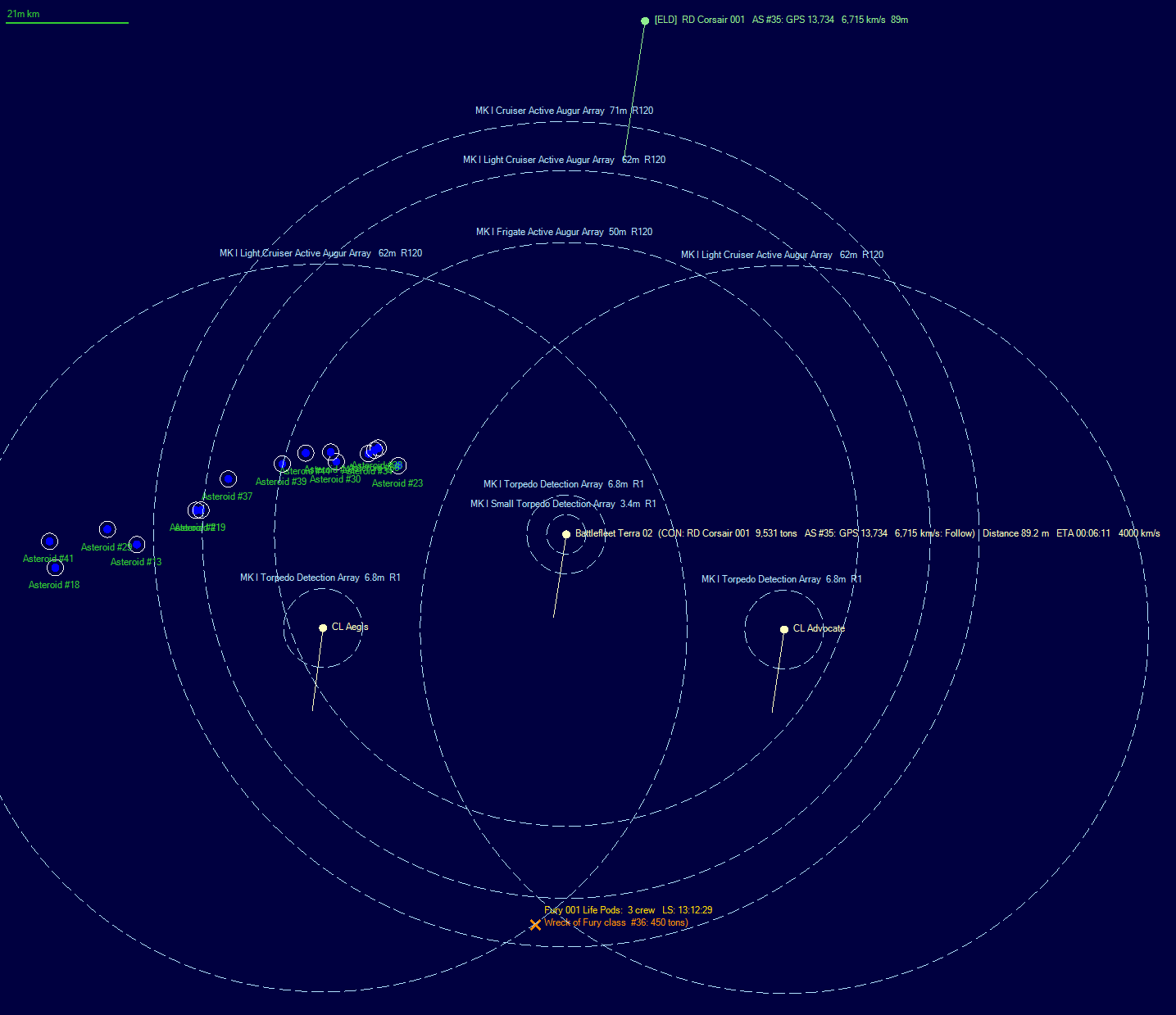
After twice more finding the alien ship, only for it to move away, Captain Merrick decided to try a new tactic. He launched his Starhawks, but ordered them to remain stationary with no active emissions, while his ships moved back toward the inner system. Over the next few hours, the alien sensor emissions were detected several times by the sensor outpost on Proxima I as the Corsair continued its manoeuvres. The Starhawks, relying on their small size to avoid detection, continually edged closer and tried to anticipate the location of the Corsair’s next appearance. Their efforts paid off when the alien sensor emissions appeared just within their weapon range and between the bombers and the primary. Given the high speed of the alien, the chance of a successful attack was marginal if the Corsair ran from the torpedoes, so they tried to move behind it at twenty percent normal speed to achieve a closer intercept if it reversed course.
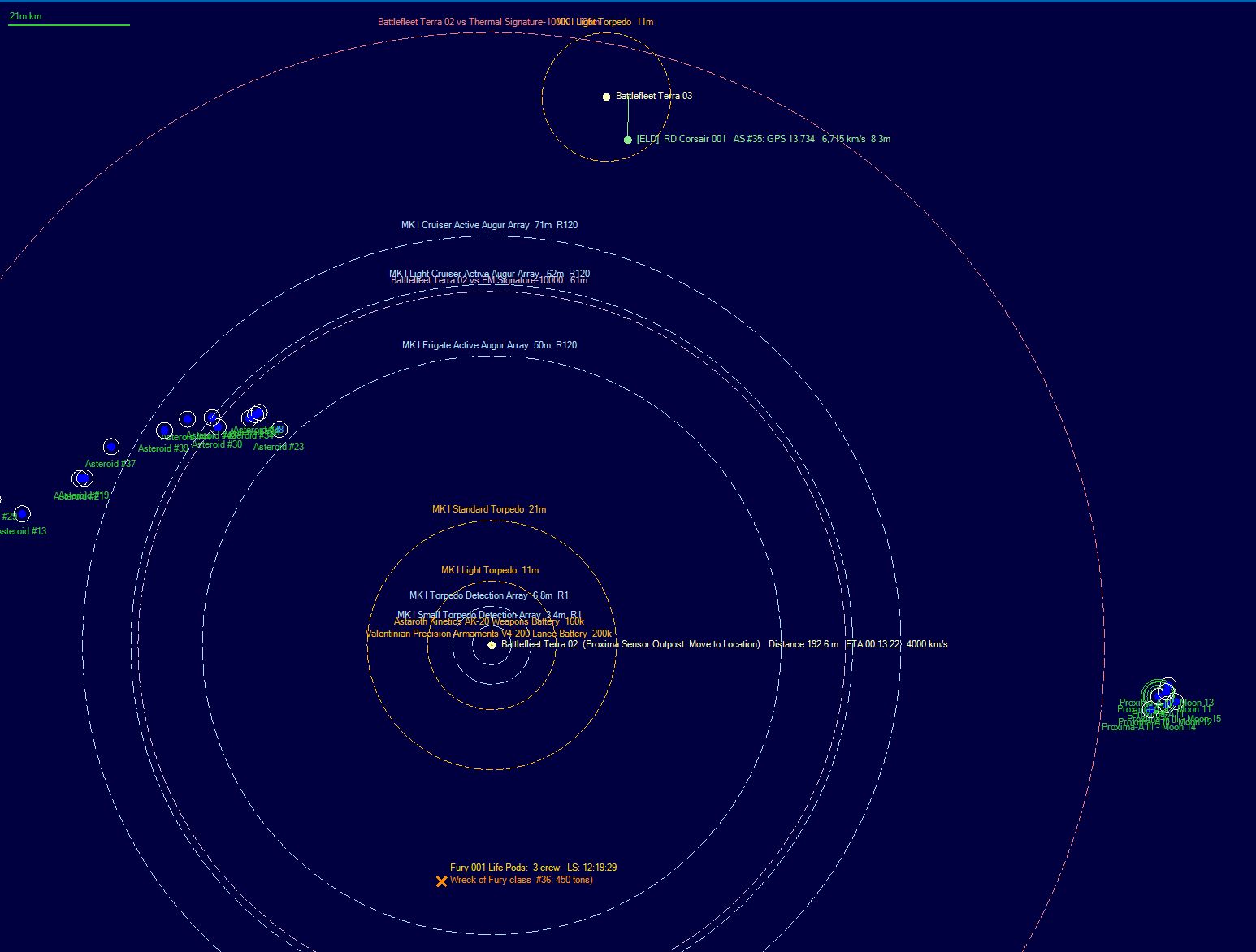
The Starhawks apparently remained undetected and the range dropped to only seven million kilometres, well inside their eleven million kilometre weapon range. Captain Merrick ordered them to engage active sensors, accelerate to maximum speed and launch their torpedoes. The sixteen bombers carried a total of one hundred and ninety-two torpedoes, which seemed like overkill. However, the alien was fast, well-armed and apparently had more advanced technology than the Imperium. Merrick decided he would rather risk wasting torpedoes than send too few and waste the chance he had created. The alien vessel destroyed six of the torpedoes with short-range point defence. The other one hundred and eighty-six all missed the target.
The tactical officers of the Imperial Navy task group were stunned. A review of the data revealed that the alien vessel had a high level of electronic countermeasures. Combined with its speed of 6,715 km/s versus the 24,000 km/s of the light torpedoes, that was sufficient to evade the inbounds. That discovery put the Imperium in a very difficult situation. The strength of the alien armament suggested it could outrange all Imperium weapons except for the bombardment cannon of the Space Marines and it could outrun every Imperial warship. It was also apparently impervious to the current generation of torpedoes. The only option seemed to be a mass attack by Fury class interceptors, but they would take huge casualties as they slowly closed to a range where they might be effective.
Captain Merrick conferred with his superiors in the Imperial Navy and advised a strategy of containment until the Imperium could devise a solution to its technological problems. The alien seemed keen to avoid combat with the much larger Imperium force, and was probably unaware of its own advantages in energy-range combat, so Merrick proposed his force push it away from the inner system. Otherwise, traffic between the Imperium and its two most important colonies in Nocturne and Damocles would cease. With any luck, the alien would run to the jump point from which it entered, with the likely candidates being Stygia and Tau Ceti, allowing the Hermes class platforms at the jump point to detect it, albeit briefly. After being referred to the Lords of Terra, given the seriousness of the situation, permission was given. The task group moved back toward the intruder while the Starhawks took a circuitous route back to Archon Kort.
The light cruisers Aegis and Advocate were deployed once more to create a much wider sensor net. For several days, the task group pushed the Corsair away from the inner system, as it danced in and out of sensor range, using its own active sensors intermittently. Each time it appeared on a different heading, as if it was trying to move around the task group. Solar Admiral Barachiel Endymion ordered the colony ships in Nocturne to head for home, moving across Proxima behind the shield provided by the Imperial Navy. Suddenly, the Corsair appeared once again, moving straight across the path of the task group instead of the previous cautious manoeuvring. Its high speed took it past the Imperium warships, which suddenly found themselves playing catch-up.
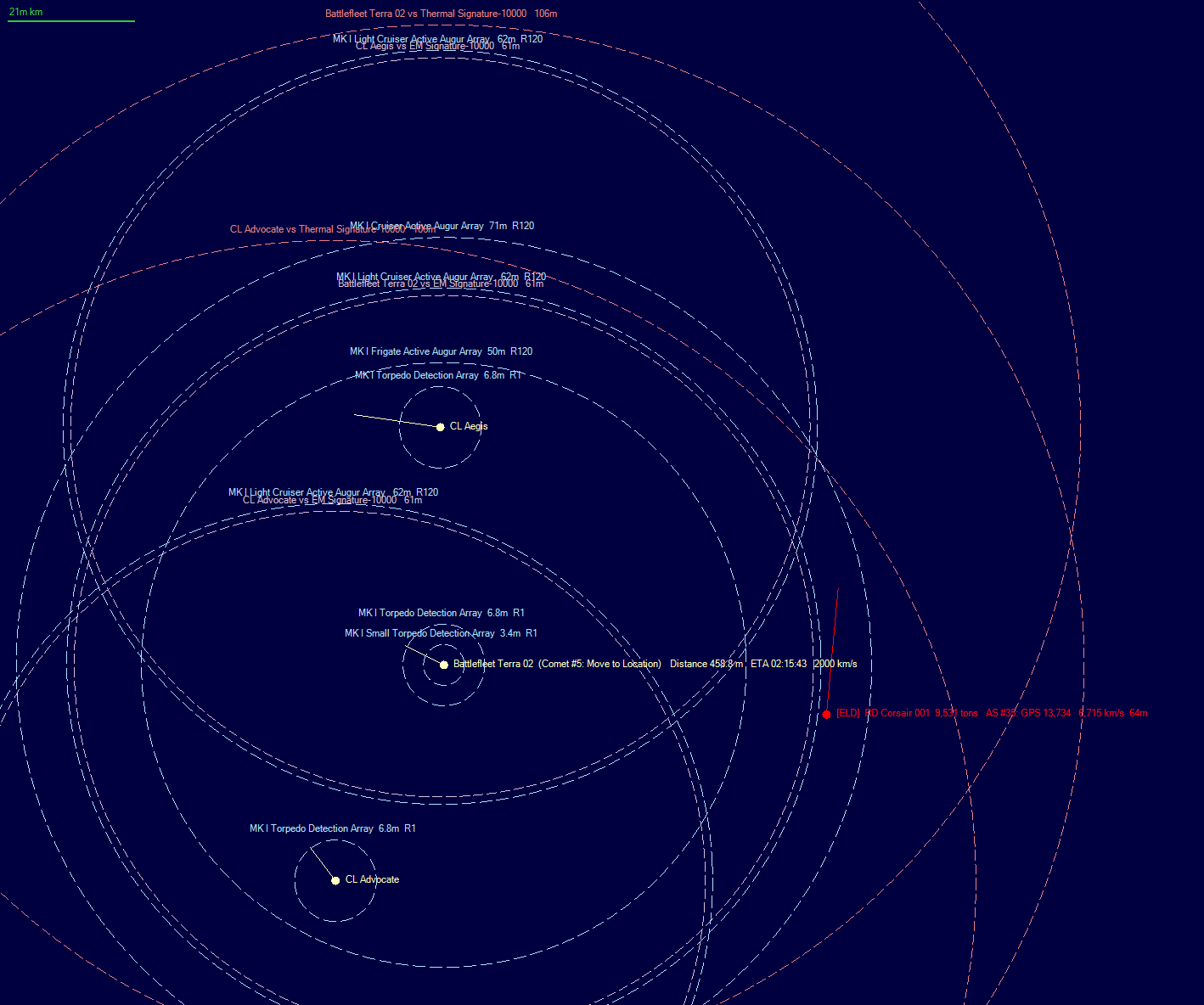
The Lords of Terra asked the Raven Guard Space Marine Chapter to provide support. Its ships broke Terra orbit immediately, trying to reach the inner system of Proxima before the lone raider. That support became more urgent when the Imperial Navy task group lost contact with the alien. The last known position was half a billion kilometres from the primary, between the task group and the inner system. Contact was briefly re-established when the Corsair activated its sensors less than three hundred million kilometres from the star, apparently on course for the Proxima III Lagrange Point. Another short-lived detection occurred a few hours later as it passed close by the Trojan asteroids around the Lagrange Point, on a course that had no obvious destination but would eventually pass within a hundred million kilometres of the Sol jump point.
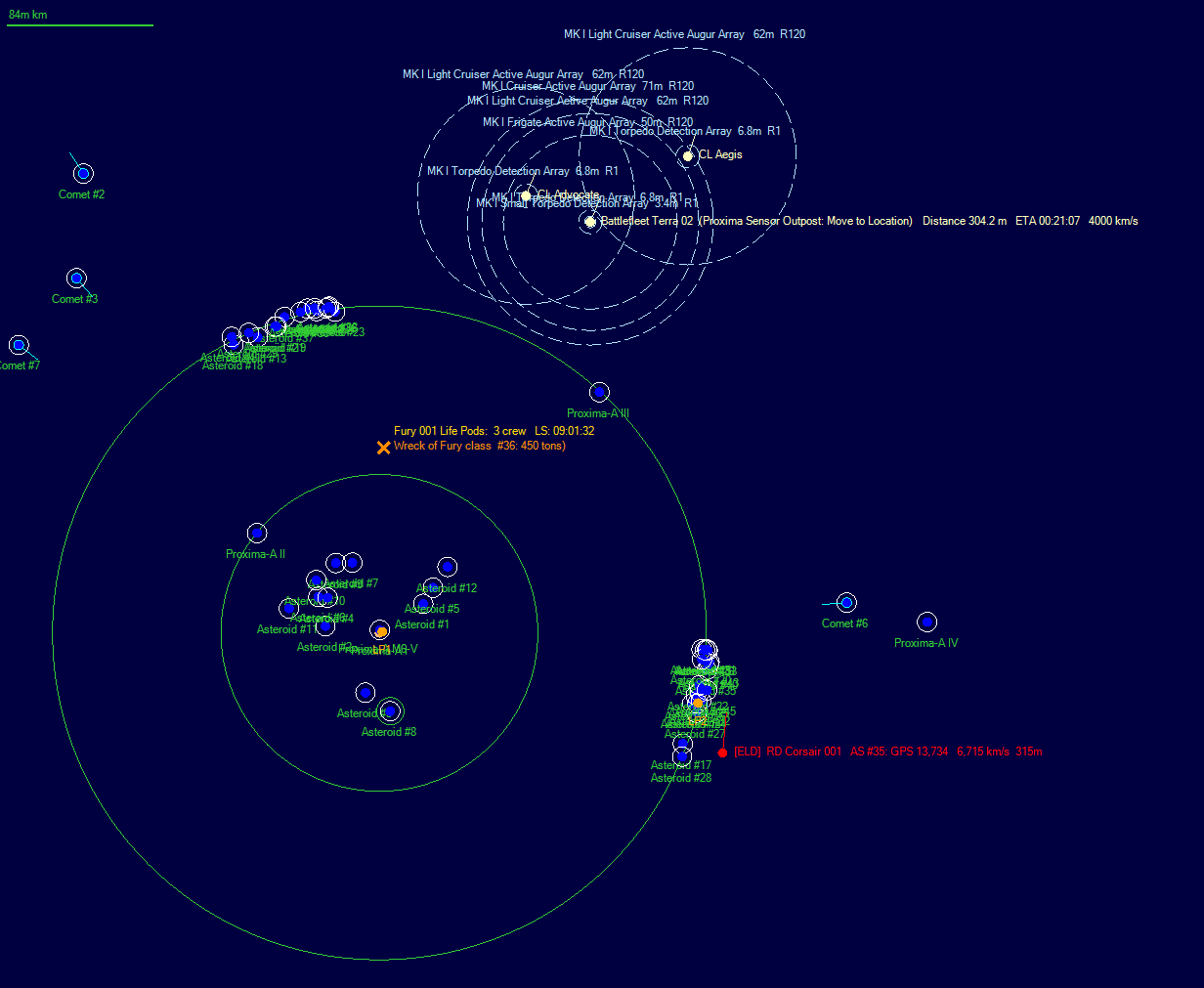
Six hours after the last detection, the warships of the Raven Guard, under the command of Captain Alvarex Corvus, transited into Proxima from Sol. The Battle Barge Spear of Vengeance was accompanied by the strike cruisers Angelica Mortis and Covenant of Blood and the Nova class frigates Nova, Pulsar and Quasar. The Raven Guard moved on to the last known course of the Corsair and detected its sensor emissions seven hours later at a range of one hundred million kilometres. The Imperial Navy task group centred on Archon Kort was half a billion kilometres away but altered its own course to intercept. As soon as the Raven Guard set its own intercept course, the Corsair reversed course and ceased its active emissions. The single alien ship was proving to be extremely troublesome. Almost three hundred thousand tons of Imperium warships were engaged in trying to catch a single, elusive 9500-ton alien ship. However, as the Corsair continued to run away from the Raven Guard, it headed straight for the Imperial Navy task group, creating an opportunity for the two fleets.
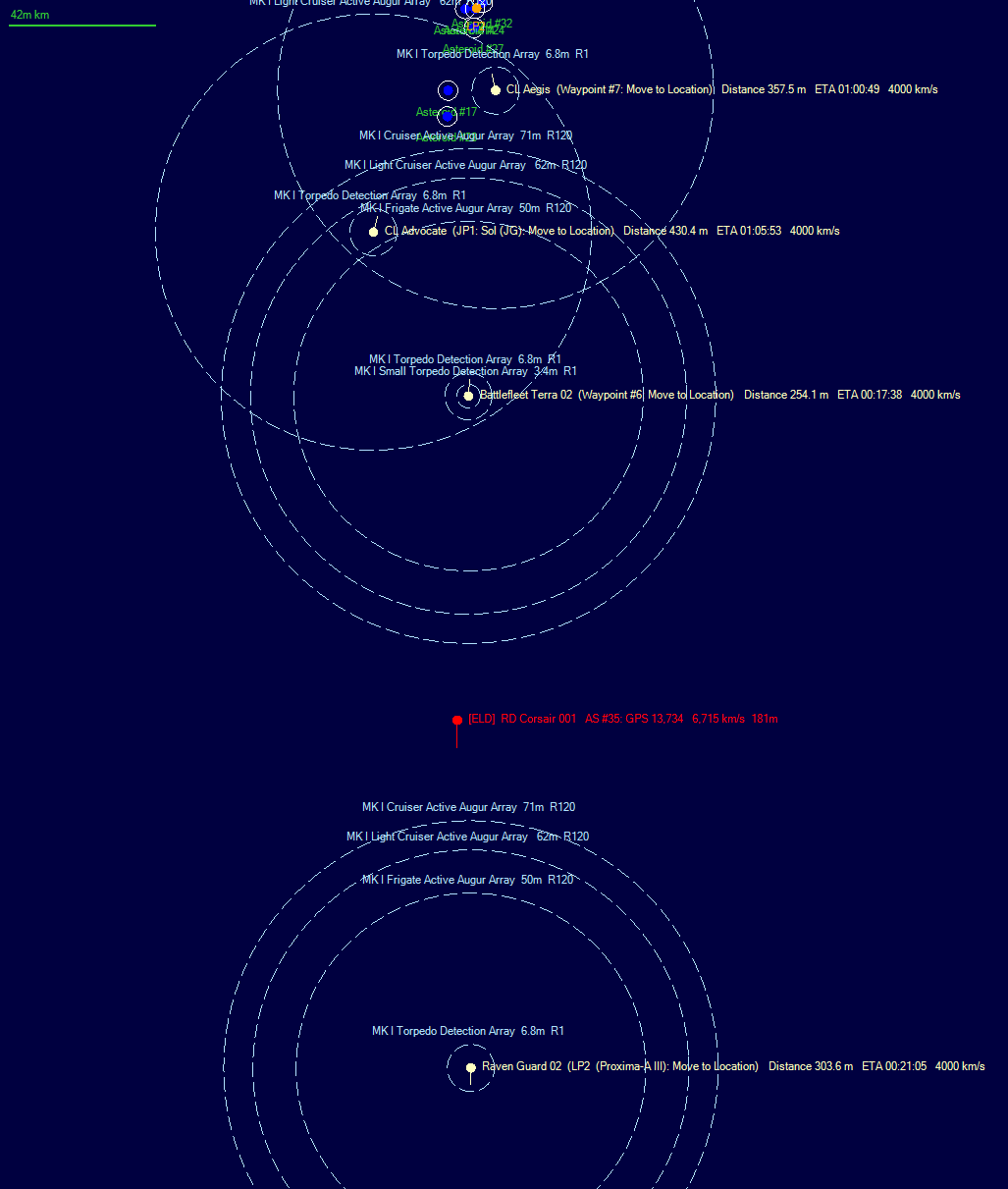
The Corsair seemed unsure what to do, reversing course multiple times as the two Imperium forces closed in. The alien was plainly keen to avoid combat, which was understandable given the weight of forces. However, Captain Merrick was concerned about his own force actually catching the Corsair. His carrier was unarmed and his six destroyers had a single weapon battery each to support their torpedo launchers. That left the light cruiser Bellerophon as his only effective combatant, along with the seven remaining Fury class interceptors on Archon Kort. The light cruisers Advocate and Aegis were well astern of the main body after their detachment as sensor pickets. The Space Marine force was in much better shape, as all six warships had bombardment cannon to support their weapon batteries.
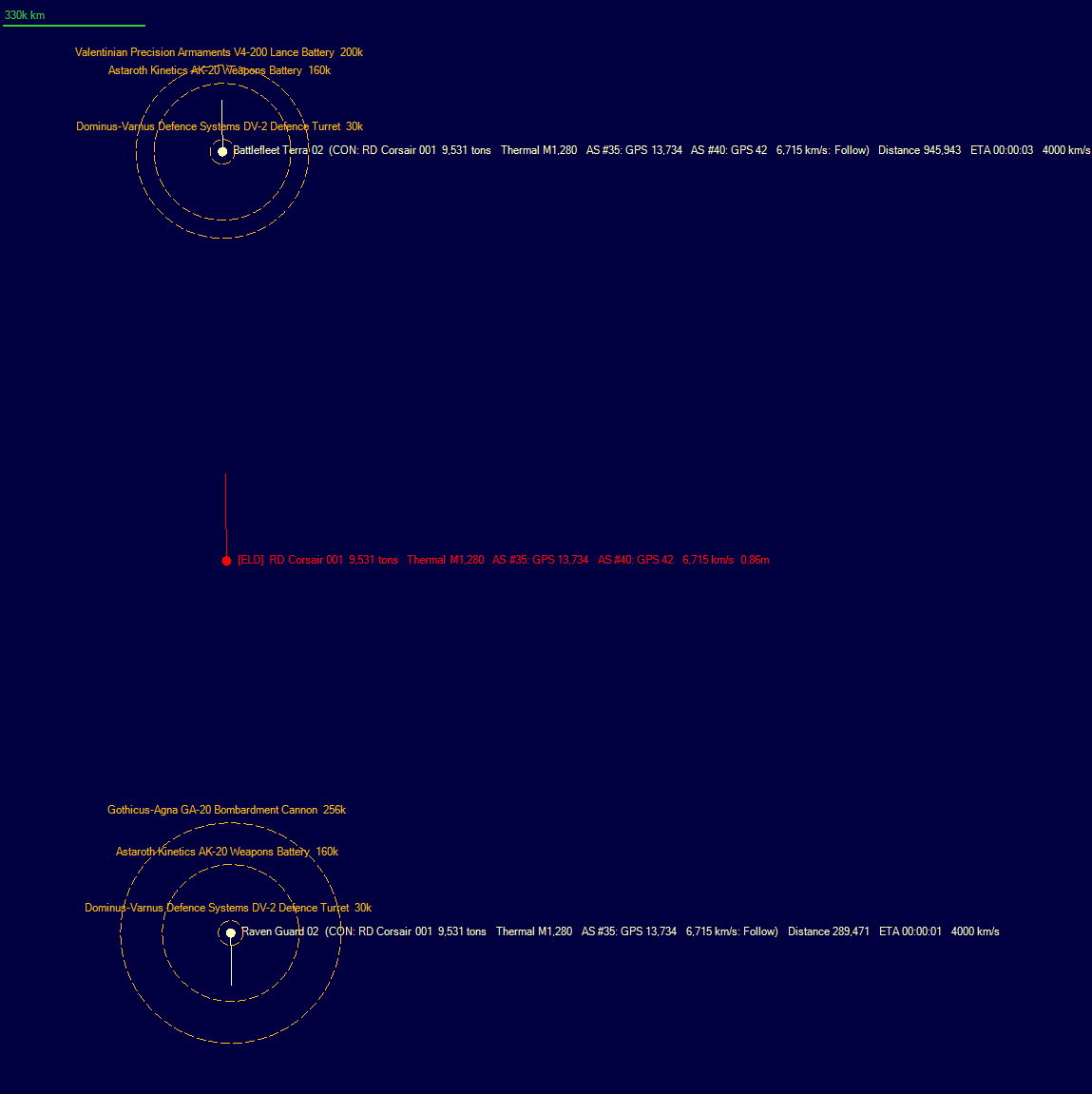
Finally, the Corsair was trapped between the two forces with nowhere to run. The alien ship opened fire on Archon Kort at 240,000 km, scoring five strength-1 hits on her shields. Captain Merrick had decided to leave the Furies in their hangar bay as the Space Marines had more than enough firepower to destroy the Corsair once they were close enough to overcome the jamming. The Raven Guard ships moved into their theoretical maximum weapon range but could not lock on due to the powerful alien electronic counter-measures. The Corsair fired again after fifteen seconds, targeting Archon Kort again with similar results. The range for the Space Marine warships dropped below 100,000 kilometres and they could still not achieve a lock. The Imperial Navy ship were at 186,000 kilometres when the Corsair fired for the third time. Archon Kort was struck twelve times but her shields were still holding.
The Corsair’s indecision came to an end and it continued closing on the Space Marine fleet, which finally opened fire at 47,000 kilometres. In total, they fired seventeen shots from their bombardment cannon and one hundred and twenty from their weapon batteries, scoring one strength-8 and eight strength-3 hits respectively. Three hits penetrated the apparently fragile armour of the Corsair and its speed dropped by fifty percent. Captain Corvus saw an opportunity to learn more about the alien and ordered his three capital ships to cease fire. The Nova class frigates continued firing in an effort to cripple the alien ship and allow a boarding attack.
The Corsair repaid the magnanimity of the Space Marines by inflicting sixteen strength-5 hits on the armour of Spear of Vengeance. The number of shots from the alien suggested that one of its five weapon batteries was out of action. The Space Marine frigates returned fire, scoring nine hits, five of which penetrated the armour but did not slow the alien ship. Whatever counter-measures the Corsair had been using had evidently been disabled by the Space Marines initial salvo. Captain Corvus ordered two of the frigates to cease fire as he intended to capture the Corsair intact and did not want to risk destroying it.
The Corsair fired on Spear of Vengeance again, still with four active weapon batteries, and caused an eighty percent penetration of her armour. Captain Marcus had been using his flagship’s armour to save the lives of the Space Marines that would be lost in a boarding action again the Corsair, while it was still travelling at 3357 km/s, but he was not prepared to risk any serious damage to the Chapter’s battle barge. The frigate Nova would fire once more, then the Second Company would launch their Thunderhawks and attack.
Nova fired, without penetrating the alien ship’s armour, then three Thunderhawks from Angelica Mortis conducted a boarding assault, losing more than half their number in their attempt to land on the Corsair’s hull. The Space Marine warships started opening the range, but were still subject to attack from the alien weapon batteries as they pulled away. Spear of Vengeance was hit by seven more salvos before moving out or range. Fortunately, the colossal battle barge was designed to absorb punishment and did not suffer any internal damage.
Despite its losses, the Second Company of the Raven Guard secured the Corsair within four minutes, losing only a single Space Marine in the actual combat. The elimination of the alien threat cost the lives of sixty-eight Space Marines and eighteen Imperial Navy personnel, as well as substantial armour damage to Spear of Vengeance, the loss of a Fury interceptor and the expenditure of almost two hundred light torpedoes, not to mention the disruption of all Imperium traffic around the Proxima system for almost ten days while major Imperial Navy and Space Marine forces hunted down a single, frigate-sized alien ship.
The Corsair itself seemed to have technology comparable to that of the Necrons, with the exception of their high level of advancement in electronic countermeasures. The engine technology was two generations of that employed on current Imperium warships, although the recent development of Ion Drive technology by the Adeptus Scientifica would reduce that gap in the near-future. The design of the Corsair was focused on speed and evasion, with forty-two percent of the hull volume dedicated to engines at the expense of passive protection. The shields and armour of a Sword class frigate accounted for sixteen percent of its tonnage, versus only six percent for the Corsair. With long-range sensors, high speed and substantial fuel reserves, the Corsair was ideal as a raider, designed to prey on commercial traffic rather than fight warships.
Corsair class Raider 9,531 tons 298 Crew 2,025.3 BP TCS 191 TH 1,280 EM 0
6715 km/s Armour 3-40 Shields 0-0 HTK 71 Sensors 11/11/0/0 DCR 4 PPV 40
Maint Life 1.34 Years MSP 531 AFR 182% IFR 2.5% 1YR 316 5YR 4,743 Max Repair 320 MSP
Commander Control Rating 2 BRG AUX
Intended Deployment Time: 6 months Morale Check Required
Magneto-plasma Drive EP640 (2) Power 1280 Fuel Use 50.0% Signature 640 Explosion 10%
Fuel Capacity 790,000 Litres Range 29.8 billion km (51 days at full power)
25cm Weapon Battery (5x4) Range 250,000km TS: 6,715 km/s Power 15-5 RM 50,000 km ROF 15
Beam Fire Control R320-TS6750 (2) Max Range: 320,000 km TS: 6,750 km/s 97 94 91 88 84 81 78 75 72 69
Stellarator Fusion Reactor R5 (5) Total Power Output 27.3 Exp 5%
Active Search Sensor AS100-R109 (1) GPS 13734 Range 100.3m km Resolution 109
Active Search Sensor AS12-R1 (1) GPS 42 Range 12.1m km MCR 1.1m km Resolution 1
Thermal Sensor TH1-11 (1) Sensitivity 11 Detect Sig Strength 1000: 26.2m km
EM Sensor EM1-11 (1) Sensitivity 11 Detect Sig Strength 1000: 26.2m km
ECCM-4 (1) ECM 40
The alien corpses were tall, thin humanoids with alabaster skin, wearing light armour that was almost Gothic in design. The stretched nature of their features, including pointed ears, led to an initial comparison with the elves of ancient Terra myth and eventually the official adoption of an early colloquial name for the aliens: the Dark Eldar. The origin of the ship itself was unknown. It could have arrived though one of the existing jump points before the Hermes platforms were in place, or it may have arrived via a previously dormant jump point. A full resurvey of Proxima was authorised to check the latter possibility.
In the adjacent system of Nocturne, the Ordo Xenos completed their work on the alien ruins and the ancient construct. As in Damocles, the ancient structure was devoted to research, in this providing a boost to Energy Weapon research of up to seventy percent. The ruins of the alien colony, perhaps created by a long-dead race to study the construct, contained fifty-two locations designated for further investigation by the Ordo Machinum.
In March 4003, a complete gravitational resurvey of Proxima was completed without detecting any new jump points. The origin of the Dark Eldar remained a mystery. By August, most of the systems within two transits of Sol were fully surveyed, so the Lords of Terra ordered the Imperial Navy, including the survey ships of the Adeptus Astronomica, to begin the third phase of exploration, with the systems around Proxima given priority. Damocles, Tai Ceti and Stygia each had a single outward jump point while Nocturne had three. All six jump points led to unremarkable dwarf star systems.
By the end of 4003, only three more jump points had been explored; one from Equinox, a system beyond Alpha Centauri, which led to an unremarkable brown dwarf system, and two from the critical system of Orpheus. The first led to the planetless system of Graildark and the second to Avalon, an M4-V red dwarf. Avalon had eight planets and almost eighty moons. Avalon I was a terrestrial world, larger than Earth with gravity of 1.08G and a breathable nitrogen-oxygen atmosphere of 1.15 atm. The temperature was -85C and ninety-eight percent of the surface was covered in ice sheets. As the world was tide-locked, the colony cost was only 0.63. The geological survey was disappointing though. Eight minerals were present in vast quantities, but mainly low accessibilities.
On December 20th 4003, a Dark Eldar Corsair was detected in Damocles, a system adjacent to Proxima that was home to a colony of seven million with a research facility, twenty maintenance facilities and a tracking station. The planet was also the site of an ancient construct dedicated to defence research. The Dauntless class light cruiser Guardian, the Sword class frigate Final Silence and the replenishment ship Brigantine Sapphire were in orbit of the colony. The senior officer in Damocles was Commander Azrael Endymion, nephew of Barachiel Endymion. The First Regiment of the Elysian Drop Troops, an Imperial Guard infantry regiment, and the Hyperion Guard, a planetary defence regiment, were on the surface.
The aliens had not entered through the Proxima jump point, because a Hermes class Sensor Platform was stationed on the Proxima side. The only other potential entry point was the jump point from the recently discovered Sicarius system, which was less than fifty million kilometres for the primary and therefore well within sensor range of the tracking station on Damocles Prime. Sicarius itself was home to two planets, thirty-odd moons and an asteroid belt, all of which were barely thirty degrees above absolute zero. The question of the alien’s origin point would have to wait though as the alien ship was on a direct course for the Imperium colony.
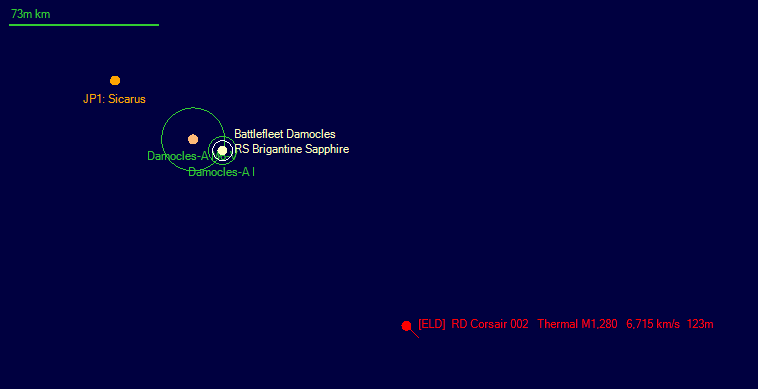
Given the difficulty in running down the Corsair in Proxima and a desire to avoid a mass fleet deployment every time a single ship was encountered, the Lords of Terra decided on a strategy of containment. The light cruisers Cerberus and Dauntless and the Firestorm class frigates Kraken and Medusa were dispatched from Terra with orders to picket the Damocles – Proxima jump point, which would prevent the Corsair moving toward the rest of the Imperium. The two warships in orbit of Damocles Prime, designated as Battlefleet Damocles, were ordered to remain close to the planet and coordinate their efforts with the Hyperion Guard regiment, which had eight Medusa surface-based lance batteries and four Hydra point defence batteries. Commander Azrael Endymion ordered the replenishment ship Brigantine Sapphire to break orbit and move away in the opposite direction.
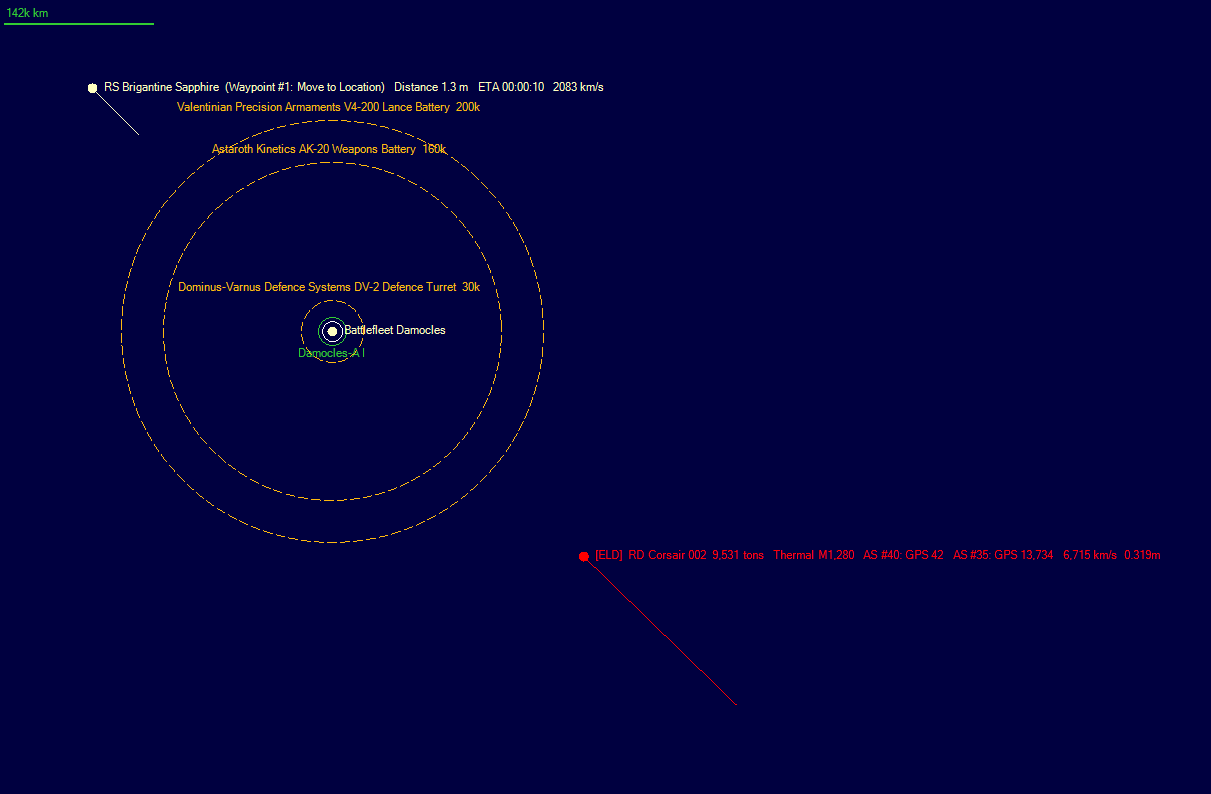
Once the Corsair was within 250,000 km, Guardian and Final Silence began to back away, trying to draw the Corsair close to the planet where the surface-based weapons could engage. The Corsair opened fire on Guardian at 238,000 km, scoring five strength-1 hits on her shields. A few seconds later, the lance batteries of the Hyperion Guard returned fire at 185,000 km, missing with all eight shots. The Corsair fired once more at 197,000 km from Battlefleet Damocles and 118,000 km from the planet, scoring a further eleven strength-1 hits on Guardian. Even though the light cruiser’s shields were still at eighty-seven percent, the long-range accuracy of the Corsair was concerning. Moments later the planetary batteries fired and missed again, even though the range had fallen to 84,000 km.
Guardian and Final Silence could not even achieve a weapon lock, so Commander Endymion ordered both ships to reverse course, trying to close the range enough to open fire while the alien ship was close to the planet. Both sides exchanged fire with the Corsair 21,000 km from Damocles Prime and 77,000 km from Battlefleet Damocles. Guardian and Final Silence had three lance batteries and twelve weapon batteries between them, with a total of fifty-one shots. They scored a single hit from a weapon battery. In return, Guardian suffered fourteen strength-3 impacts, reducing her shields to forty-five percent. However, the Dark Eldar ship had strayed close enough to the planet to bring it within range of the four Hydra planetary defence batteries, each of which had the equivalent of a warship defence turret. The Corsair took ten strength-1 hits.
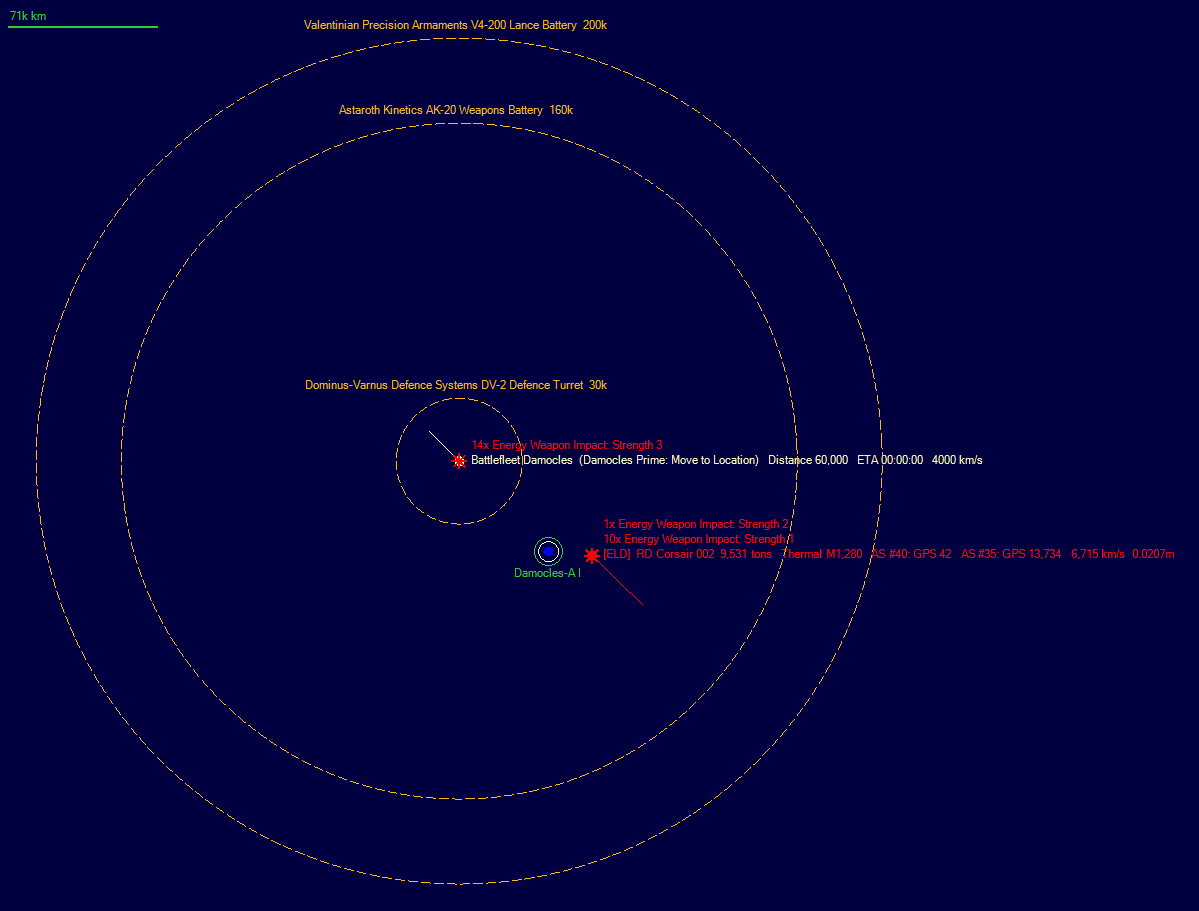
Either dissuaded by the surface-based weapons or trying to keep the range open, the Corsair reversed course away from the planet. The eight Medusas fired again without success. Knowing his own ships would be outclassed if they chased the Dark Eldar away from Damocles Prime, Commander Endymion ordered them to pull back, keeping the planet between them and the Corsair. The alien ship gave chase, moving within 23,000 km of Damocles Prime and opening fire on Guardian at 98,000 km, inflicting twelve strength-2 hits. The light cruiser’s shields fell to less than a quarter strength. Commander Endymion’s efforts to draw fire were successful though as the Hydra point defence batteries scored five strength-1 hits, one of which caused atmosphere to stream from a wound in the side of the alien ship. The Corsair was fast and difficult to hit, but it could not take much punishment.
The Corsair moved away again, but this time only at half speed. The single hit that penetrated its armour had apparently knocked out an engine. While its ECM was still active, the slower speed of the Corsair increased the Imperium ships’ chance to hit. The eight Medusa lance batteries fired for the fourth time and scored two strength-4 hits. Commander Endymion tried to entice the alien ship back toward the planet, but it had abandoned its manoeuvres and was plainly running. With the two sides moving apart, the range from the Corsair to Battlefleet Damocles had opened to 149,000 km. Too far from the Imperium ships to achieve a lock, even with the reduced speed of the enemy ship, but close enough for the Corsair to hit Guardian seven times.
Battlefleet Damocles gave chase. Guardian and Final Silence had a speed advantage of 643 km/s, so it would take some time to move within effective weapon range, The alien had only moved to 86,000 km from Damocles Prime though, allowing the Medusa lance batteries to inflict three more strength-4 hits.
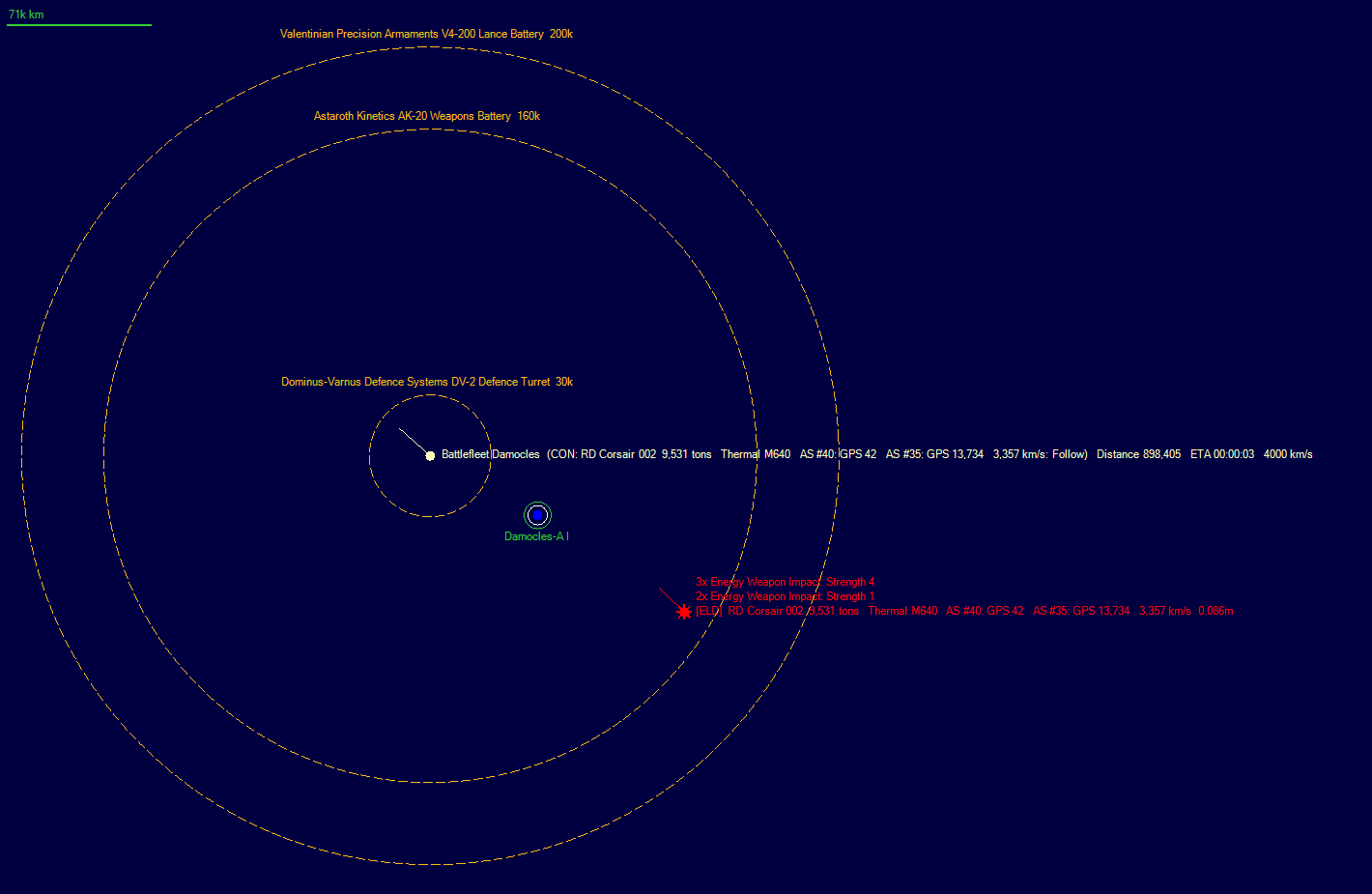
A running battle began. Guardian and Final Silence started to score occasional strength-1 hits from the point they passed the planet, still 136,000 km from the Corsair. The Corsair retained all its weapon batteries, which became increasingly effective as the range fell. Guardian’s shield strength was worn away by multiple strength-1 hits, then her armour suffered multiple impacts as a barrage of fifteen strength-2 hits blasted through the remnants of her shields at 120,000 km. Moments later, Guardian achieved two strength-4 lance hits on the Corsair, both of which penetrated its armour. The planet-based weapon batteries had achieved a single further hit before they were out of range.
All five of the alien weapon batteries remained in operation. At 110,000 km/s, Guardian took another battering, with fourteen strength-2 hits resulting in multiple deep armour penetrations. The punishment taken by Guardian was deemed acceptable by Commander Endymion, as his ships’ inferior weapons and fire control were becoming more effective as the range fell. Twenty percent of the shots from their next volley struck the alien, albeit without any apparent damage to engines or weapons. The weight of damage though was still firmly in favour of the Dark Eldar. After two more alien volleys, Guardian’s armour was completely penetrated in four locations, although she had yet to suffer internal damage.
While Guardian’s armour was disintegrating under the alien assault, the frigate Final Silence was outperforming her larger companion, achieving more hits than the light cruiser in two consecutive volleys, despite having less than half the armament. Finally, with the range at 87,000 km, both Imperium ships combined to deliver a devastating blow. The Corsair was staggered by two strength-4 and twenty strength-1 impacts, over half of which penetrated her armour, leaving the Dark Eldar ship dead in space.
Commander Endymion on the Guardian pulled his own ship back and ordered Final Silence to close in for the kill. The frigate’s shields were intact, while the light cruiser was likely to be badly damaged by another alien volley. Final Silence moved to 47,000 km. Only two alien weapon batteries were still operating, but they were still enough for a last, defiant salvo that reduced the frigate’s shields to thirteen percent, before Final Silence lived up to her name and left nothing but debris drifting silently in the void. Guardian, Final Silence and the replenishment ship Brigantine Sapphire all headed back to Damocles Prime. Once the four warships originally intended to picket the Proxima jump point arrived in Damocles, Commander Endymion would take his ship back to Terra for repairs.
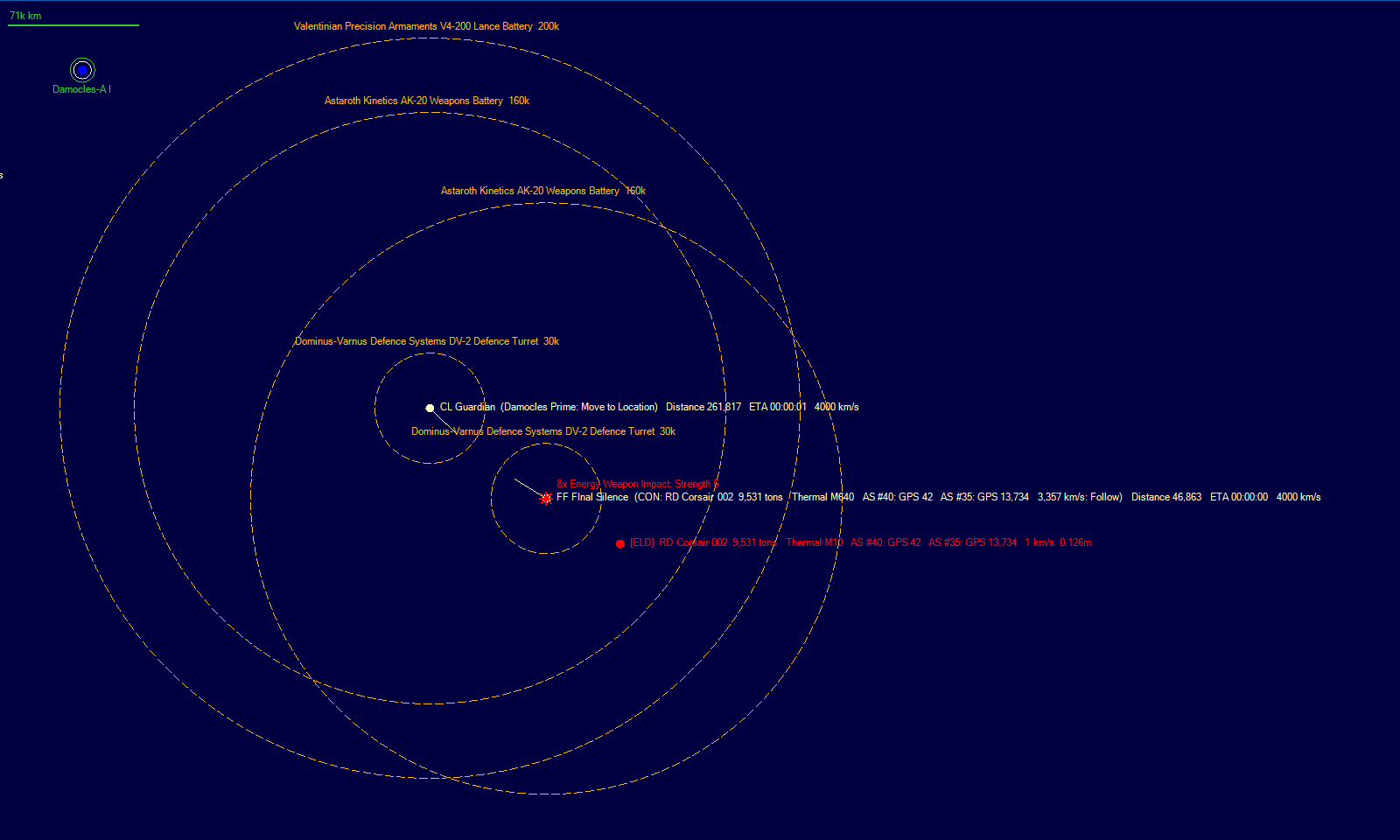
Thirty-two hours after the destruction of the Corsair, the tracking station on Damocles Prime detected two new Dark Eldar contacts, both of a new type designated as Raptor class. Their speed was 6711 km/s and their thermal signature was double that of the Corsair, suggesting they were twice as large. Once again, there was no indication of their origin. Given that the single Corsair had proved so difficult to destroy, it seemed very unlikely that Guardian and Final Silence could destroy two larger Dark Eldar vessels. The four warships initially sent to guard the Damocles – Proxima jump point were still two and a half days away and they would be probably be insufficient in any event. A new fleet was assembled from Battlefleet Terra, comprising two Lunar class cruisers, two Dictator class carriers, two light cruisers and six frigates, and dispatched to Damocles.
Two hours after the initial contact, five further Dark Eldar vessels were detected in company with the two Raptors. Four were Corsairs and the last was a new type, designated as Venom class, that had the same thermal signature as the Corsair. This new force was assumed to have approximately ten times the combat capability of a single Corsair class raider, which made it extremely dangerous despite being less than ninety thousand tons in total. The Lords of Terra asked the Raven Guard Space Marine Chapter to join the force heading for Damocles. The Chapter Master, Kor Aurelius, agreed to the request, with the proviso that his Chapter would be delayed for a few days while they loaded their entire ground force for transport to Damocles Prime.
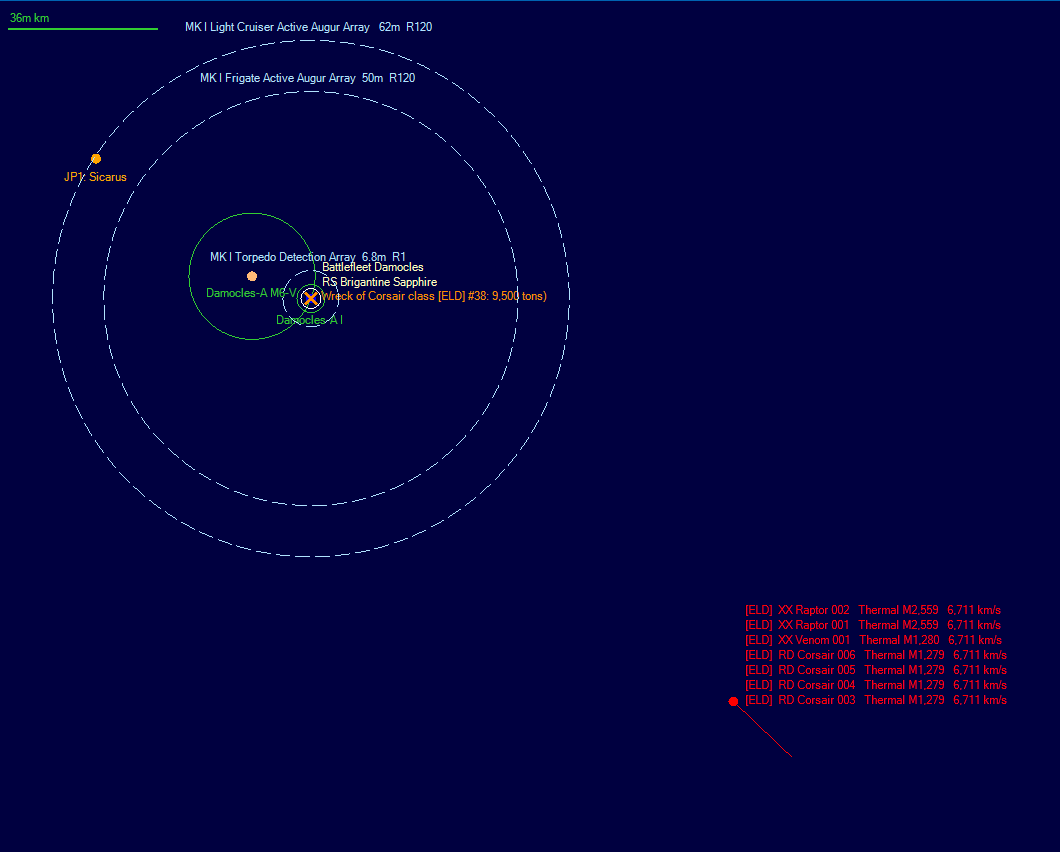
Meanwhile in Damocles, Commander Endymion and the crews of his two ships prepared for a battle they could not possibly win. The replenishment ship Brigantine Sapphire was jump capable so he ordered it to retreat into the Sicarius system and move far from the jump point in an attempt to hide. Guardian and Final Silence did not have that option and Commander Endymion planned to stand with the planetary defences even if they did. His bravery was overruled by Vice Admiral Uziel Gaunt, commander of the Battlefleets of the Imperial Navy. The alien ships were still a hundred and forty million kilometres from the planet, so he ordered Commander Endymion to retreat away from the approaching Dark Eldar fleet in an attempt to hide in the outer system.
Commander Endymion pointed out that the Corsair had a known sensor range of a hundred million kilometres. Even if his own ships ran, the alien fleet would be within that sensor range in four hours, while still en route to the planet. That was assuming the larger ships did not have more capable sensors and were already in range. Given his ships would very likely be run down and destroyed anyway, Endymion stated his desire to support the Hyperion Guard instead. With reluctance, Vice Admiral Gaunt gave his permission.
Battlefleet Damocles adopted the same tactic as the previous engagement; withdrawing behind the planet in an attempt to draw the alien ships close to the surface-to-orbit batteries before engaging. The Dark Eldar fleet ignored the two warships and the Raptors and Corsairs opened fire on Damocles Prime from 236,000 km. The Raptors were armed with twelve weapon batteries, compared to the five of the Corsair. The Venom did not fire. One hundred and sixty-eight shots were recorded, resulting in the destruction of two of the eight Medusa lance batteries and one of the four Hydra defence batteries. Thirty-two thousand civilians were killed as a result of the heavy bombardment.
Commander Endymion immediately ordered his ships forward to engage. The lance batteries on the surface returned fire at 168,000 km, without success. The Dark Eldar fired a second volley from 135,000 km, destroying a third Medusa and all three of the remaining Hydras. A further sixty-eight thousand civilians were killed. The lance batteries responded, scoring two hits on one of the Corsairs. Battlefleet Damocles moved within 150,000 km of the Dark Eldar, at which point the alien fleet reversed course and fired on Guardian, blasting down her shields with a single volley. Neither of the Imperium warships could achieve a weapon lock at that range.
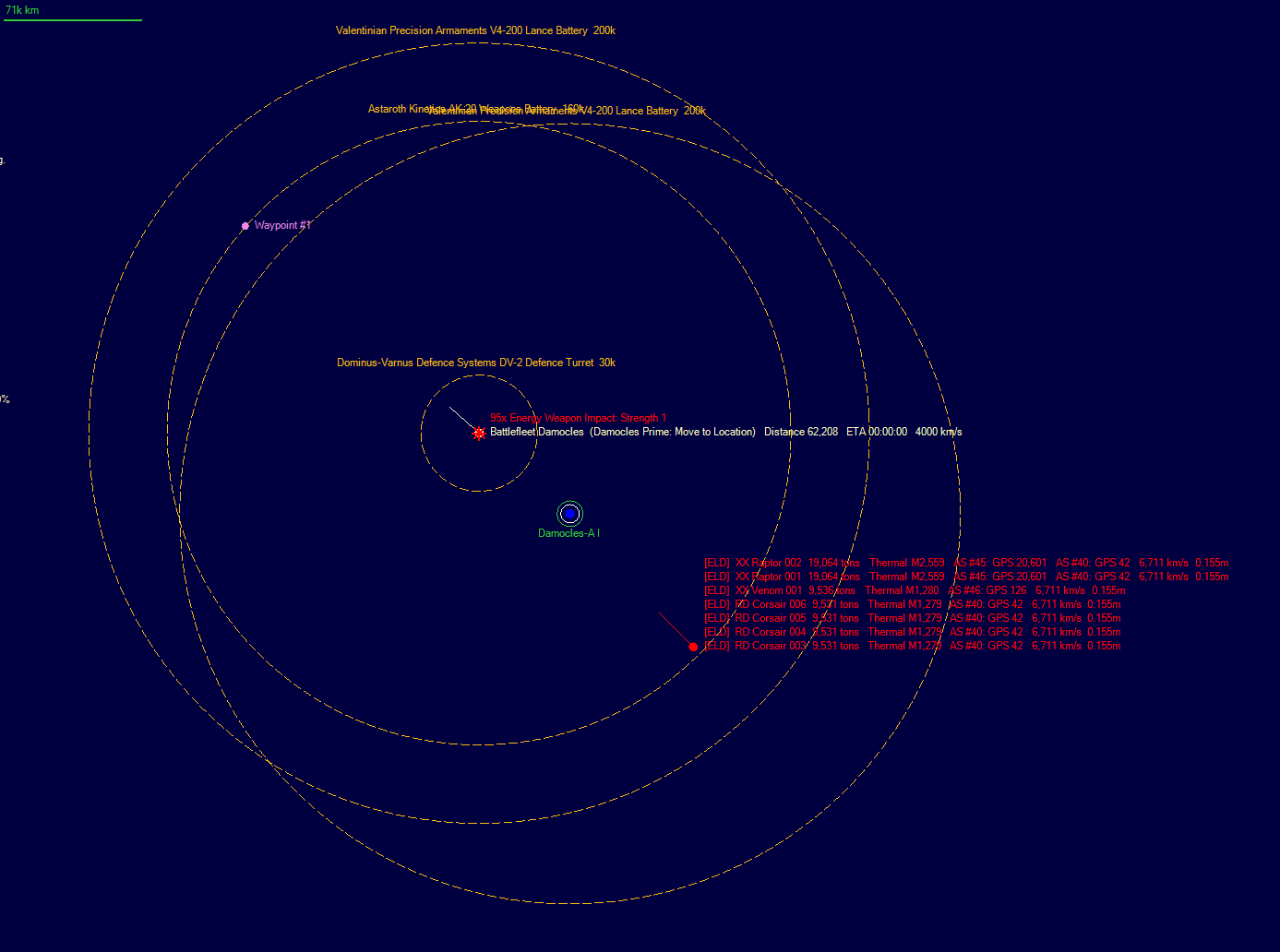
Commander Endymion ordered a course reversal, trying to draw the alien fleet back toward the planet. The Dark Eldar gave chase, allowing the five remaining Medusa lance batteries another shot, which they missed. The Raptors and Corsairs fired on Guardian with devastating effect against her already compromised armour. The light cruiser lost both engines and both shield generators. The ninth Dark Eldar ship, designated as Venom class, fired on Damocles Prime with fifteen light weapon batteries, destroying two Medusas and killing another twenty-eight thousand civilians. The battle was going even worse for the Imperium than Endymion had feared.
Final Silence had no option but to charge the Dark Eldar and hope they allowed her into range. The Dark Eldar simply reversed course again and kept her at 155,000 km, where she could not achieve a weapon lock. The alien warship ignored the charging, but ineffective frigate, and fired again on Guardian at 235,000km, scoring forty-four strength-1 hits and disabling a weapon battery, a lance battery and her primary sensor.
The three remaining Medusas continued firing, but still with no effect. Final Silence reversed course, as pursuing the faster aliens was futile. All she could hope to do was draw them into range of the Medusas and hope for a lucky hit. The Dark Eldar also reversed course and continued to pound the helpless Guardian. The light cruiser absorbed another two full salvos, but almost all her systems were wrecked. Commander Azrael Endymion was killed by a direct hit on his bridge. Another Medusa was destroyed as the Venom fired on Damocles Prime.
Guardian exploded under heavy fire. Commander Lucian Thule, captain of the Final Silence, knew there was nothing his ship could do against the Dark Eldar, so he gave the order to run in the faint hope that the aliens would remain near the planet. The Venom hit Damocles Prime with two further volleys, wiping out the last surface-to-orbit weapons of the Hyperion Guard, then the whole fleet moved in pursuit of Final Silence. Three full volleys reduced the gallant frigate to tumbling wreckage.
The Imperium had lost a Dauntless class light cruiser, a Sword class frigate and a dozen surface-based weapons. Civilian casualties on Damocles Prime exceeded two hundred thousand, although the Dark Eldar showed no interest in bombarding the surface once the weapons of the Hyperion Guard were silenced and instead set off in pursuit of Brigantine Sapphire, which was closing on the Sicarius jump point. As soon as the replenishment ship transited, the Dark Eldar lost interest and headed back to Damocles Prime, picking up the Imperium life pods en route. The tracking station on the surface was still operational and sending sensor information to Terra via the stable jump network.
The ease with which the Dark Eldar fleet had destroyed the two Imperial Navy warships and the surface-to-orbit weapons was very concerning for the Lords of Terra, especially as it was done while sustaining only two minor hits. A powerful Imperial Navy fleet was en route to Damocles, with support following from the Raven Guard Space Marine Chapter, but the Lords were reluctant to engage the Dark Eldar in deep space regardless of the balance of force. The Eldar had much faster ships and their huge advantage in electronic warfare also gave them a considerable range advantage. The Imperium needed to counter the Eldar jamming or to improve the effectiveness of its torpedoes.
The colonies in Orpheus and Nocturne each had a single planetary defence regiment - the Janus regiment and the Iron Tower regiment respectively – so were also vulnerable to a Dark Eldar attack. The Lords dispatched two more planetary defence regiments to each colony, leaving only one on Terra. The home of mankind was guarded by formidable forces, so the planetary defence forces were better employed protecting the colonies.
Three days after the battle, the first reinforcements, two Dauntless class light cruisers and two Firestorm class frigates designated as the new Battlefleet Damocles, arrived in the system and took up station on the Proxima jump point. The Eldar ships remained in orbit of Damocles Prime, almost a billion kilometres away. Eight hours after their arrival, a new Eldar ship appeared. The new arrival, detected by the tracking station on the planet and designated as Dying Sun class, appeared to be commercial-engined and had a thermal signature almost as large as a Cetaceous class troop transport. The immediate fear for the Lords of Terra was the similarity might be more than just engine size. The Dark Eldar could have refrained from bombarding the planet because they intended to capture it. The Dying Sun only had a speed of 2530 km/s, but was much closer to the planet than the jump point, Even with their speed advantage, the Imperium ships would not be able to intercept before it arrived.
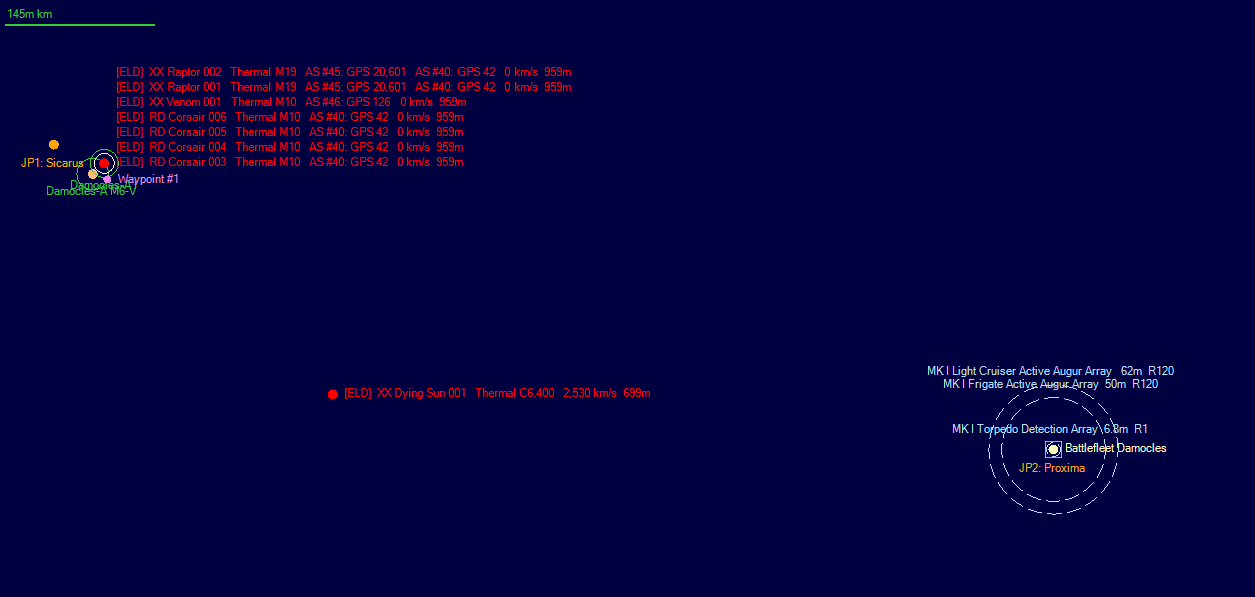
As the Dying Sun approached Damocles Prime, the tracking station detected the emissions from two Venom class ships, escorting the larger vessel. Meanwhile, the rest of the Imperial Navy reinforcements arrived in the system. Battlefleet Damocles now had a strength of two carriers, two cruisers, four light cruisers and eight frigates and was commanded by Captain Logan Macharius, a flexible and pragmatic commander who was greatly respected by those under his command.
Battlefleet DamoclesDictator class Carrier:
Archon Kort, RhadamanthineLunar class Cruiser:
Agrippa, Imperial WrathDauntless class Light Cruiser:
Cerberus, Dauntless, Hammer of Truth, RavenorFirestorm class Frigate:
Kraken, Medusa, Vengeful, VortexSword class Frigate:
Absolution, Achilles, Avenger, Mariatus15x Fury class Interceptor:
32x Starhawk class Bomber:
6x Aquila class Lander:
Despite the apparently imminent invasion of Damocles Prime, Captain Macharius had no intention of becoming engaged in a deep space battle with the Dark Eldar. In the cold calculus of war, his fleet was worth more to the Imperium than the seven million civilians on the planet, so he would guard the jump point and prevent the Dark Eldar from gaining access to the rest of the Imperium. Privately, he was beginning to wonder if the Eldar had a method of interstellar travel that did not involve jump points. As it arrived in the inner system, the Dying Sun moved to the wreck of the Dark Eldar Corsair and began a salvage operation, rather than an invasion. The population of Damocles Prime remained safe for the moment.
Five days later, the Raven Guard arrived in Damocles to boost the Imperium presence at the jump point. Between Captain Macharius of the Imperial Navy and Captain Corvus of the Raven Guard, they commanded over half a million tons of warships and faced a Dark Eldar force that was barely over a hundred thousand tons. Even so, they remained chained to the jump point, unable to risk a battle against faster ships with a longer effective range. Instead, they held their station and waited for an opportunity.